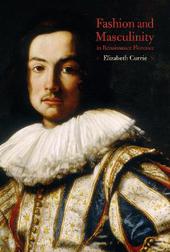
|
Fashion and Masculinity in Renaissance Florence
Hardback
Main Details
| Title |
Fashion and Masculinity in Renaissance Florence
|
| Authors and Contributors |
By (author) Elizabeth Currie
|
| Physical Properties |
| Format:Hardback | | Pages:224 | | Dimensions(mm): Height 234,Width 156 |
|
| Category/Genre | Renaissance art
History of fashion |
|---|
| ISBN/Barcode |
9781474249768
|
| Classifications | Dewey:391.1094509024 |
|---|
| Audience | | Tertiary Education (US: College) | |
|---|
| Illustrations |
40 bw illus
|
|
Publishing Details |
| Publisher |
Bloomsbury Publishing PLC
|
| Imprint |
Bloomsbury Academic
|
| Publication Date |
28 July 2016 |
| Publication Country |
United Kingdom
|
Description
Dress became a testing ground for masculine ideals in Renaissance Italy. With the establishment of the ducal regime in Florence in 1530, there was increasing debate about how to be a nobleman. Was fashionable clothing a sign of magnificence or a source of mockery? Was the graceful courtier virile or effeminate? How could a man dress for court without bankrupting himself? This book explores the whole story of clothing, from the tailor's workshop to spectacular court festivities, to show how the male nobility in one of Italy's main textile production centers used their appearances to project social, sexual, and professional identities. Sixteenth-century male fashion is often associated with swagger and ostentation but this book shows that Florentine clothing reflected manhood at a much deeper level, communicating a very Italian spectrum of male virtues and vices, from honor, courage, and restraint to luxury and excess. Situating dress at the heart of identity formation, Currie traces these codes through an array of sources, including unpublished archival records, surviving garments, portraiture, poetry, and personal correspondence between the Medici and their courtiers. Addressing important themes such as gender, politics, and consumption, Fashion and Masculinity in Renaissance Florence sheds fresh light on the sartorial culture of the Florentine court and Italy as a whole.
Author Biography
Elizabeth Currie is a lecturer and author specialising in the history of fashion and textiles. She was formerly a Research Fellow and Tutor in the History of Design at the Royal College of Art, UK and an Assistant Curator in the Furniture, Textiles and Fashion Department at the Victoria and Albert Museum, UK.
ReviewsFashion and Masculinity in Renaissance Florence is an important and welcome addition to not only sixteenth century men's dress history, but also sixteenth century gender and cultural history libraries. The book expands the understanding of not just men's dress in Renaissance Florence but Florentine society as a whole. It is accessible enough for the casual student of dress history, but knowledge of sixteenth century Florence allows the reader to fully understand the many nuances involved in the subject matter. * The Journal of Dress History * Important and illuminating ... Currie profitably mines the rich vein exposed by previous historians of clothing makes expert use of contemporary written sources on fashion and etiquette ... [The book offers] so many riches and such careful analysis. * Times Literary Supplement * This book opens up the wardrobes of elite Florentine families, showing how subtle and sophisticated the choice of dress could be in the sixteenth century. An intelligent, beautifully illustrated and original study, this is essential reading for anyone interested in how clothing "made the man" during the Renaissance. Highly recommended. * Evelyn Welch, Vice-Principal (Arts & Sciences), King's College London, UK * This insightful contribution turns a discerning and critical eye towards the clothing of sixteenth-century Florentine men. Currie skillfully explores the ways that clothing made the man within this emphatically sartorially literate society, and shows the rich, fundamental ways that power and identity were invariably "negotiated with a material reality" on elegantly dressed male bodies. * Timothy McCall, Associate Professor of Art History, Villanova University, USA * A brilliant analysis of men and the importance of dress in one of early modern Europe's fashion capitals. Readers will discover Florentine elite men as avid sartorialists propelled by their enthusiasm for new possibilities of materials and displays as much as by the intricate political and emotional games dress and accessories allowed them to play. Richly researched, this book represents a milestone in our knowledge of how sixteenth-century men conducted their lives through interacting with things. * Ulinka Rublack, Professor of Early Modern European History, University of Cambridge, UK * Elizabeth Currie vividly captures the pleasures and perils of engaging with appearances for Florentine men of the sixteenth century. Recent work on the history of clothing has taught us much about sumptuary laws, courtly etiquette, and cultures of consumption in the period. Currie teaches us more, showing how the politics and materials of dress informed the very experience of men's lives, from political posturing in the lucco, through the reputational risks attached to balancing magnificence and sobriety, to the playful freedoms sought in eroticised youthful display and dressing for the homosocial pursuits of sport and carnival. Accessible and scholarly, Fashion and Masculinity in Renaissance Florence is a valuable addition to an expanding literature on sartorial histories. * Christopher Breward, Principal, Edinburgh College of Art, University of Edinburgh, UK * Currie's book exemplifies the richness of the life history of materials, in the sense of fabrics made, decorated, and imbued with symbolic value. She brilliantly zeroes on particular public occasions and items of dress in Florence, such as the lucco, to open up the whole range of their political and cultural meanings. -- Ann Rosalind Jones, Smith College, Northampton, Massachusetts, USA Addressing important themes such as gender, politics, and consumption, Fashion and Masculinity in Renaissance Florence sheds fresh light on the sartorial culture of the Florentine court and Italy as a whole. * ADDRESS: Journal for Fashion Criticism *
|